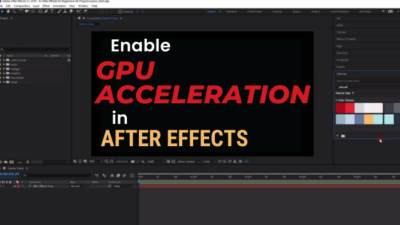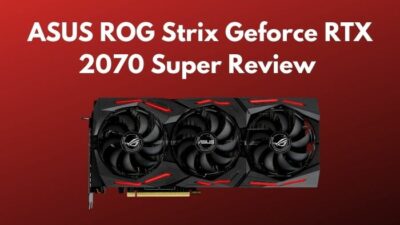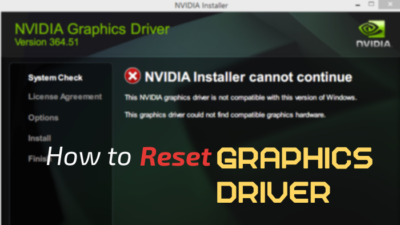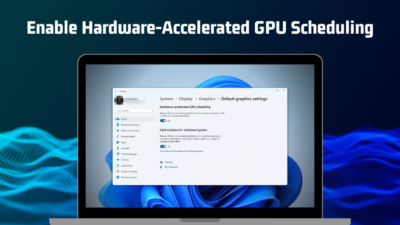You must admit; it’s annoying when the video screen is not moving synchronously. Though the VSync feature handles a smooth screenplay, it may fail to do the job occasionally.
Despite having VSync, you may see an asynchronous screen on your monitor. And the screen tearing issue must be fixed without it.
Here, I will provide six different ways to resolve the screen tearing matter.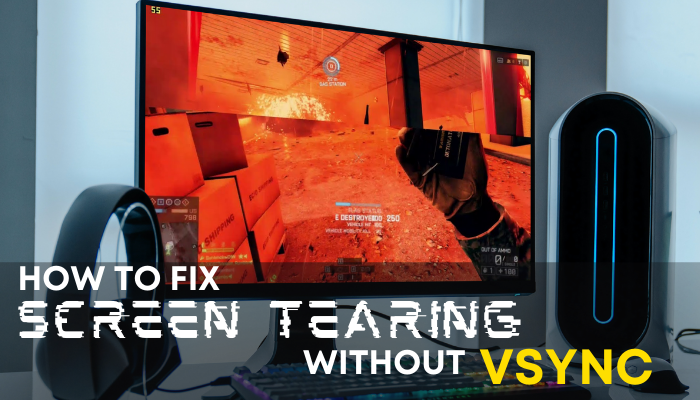
So, tag along.
How to Fix Screen Tearing Without Using VSync
Without VSync, other tools, such as G-Sync and FastSync from Nvidia, Free Sync, or Enhanced Sync from AMD, are efficient in fixing screen tearing. Besides upgrading the graphics card, adjusting the graphics settings can also reduce or eliminate screen tearing.
Are you wondering how to do that? Don’t worry. Below, I have explained all of these methods to resolve the screen tearing issue in detail.
Plus, they work on any games, especially Minecraft, Fortnite, Fallout, Valorant, Geometry Dash, etc. So, apply the methods.
Here are the methods to fix the screen tearing without the VSync:
1. Use Nvidia G-Sync or AMD FreeSync
Nvidia’s G-Sync and AMD’s FreeSync technology are terrific alternatives to V-Sync. Though they work great, they have some downsides.
These two features can’t work if the FPS surpasses the monitor’s maximum refresh rate. They can resolve the screen tearing issue as long as the FPS rate is under the refresh rate.
An example will help you to understand this easily. Let’s assume the monitor you use for playing games has a 140 Hz refresh rate. But, if the game you’re playing doesn’t require more than 130 FPS, then the G-Sync or FreeSync can work to fix screen tearing.
However, if the game starts to generate above 150 frame rate, G-Sync or FreeSync won’t function, and you will experience the screen tearing issue again.
Despite this minor drawback, they work well. And below, I have described the way to enable them.
Here is the way to enable Nvidia G-Sync and AMD FreeSync:
For Nvidia
- Right-click on the desktop screen and select the Nvidia Control Panel option.
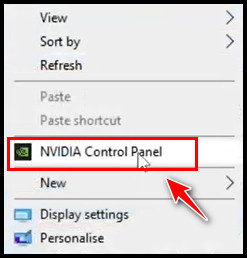
- Expand the Display option from the left panel.
- Select the Set up G-SYNC option.
- Check the Enable G-SYNC, G-SYNC Compatible option.
- Check the Enable for windowed and full screen mode and Enable settings for the selected display model box.
- Press on Apply.
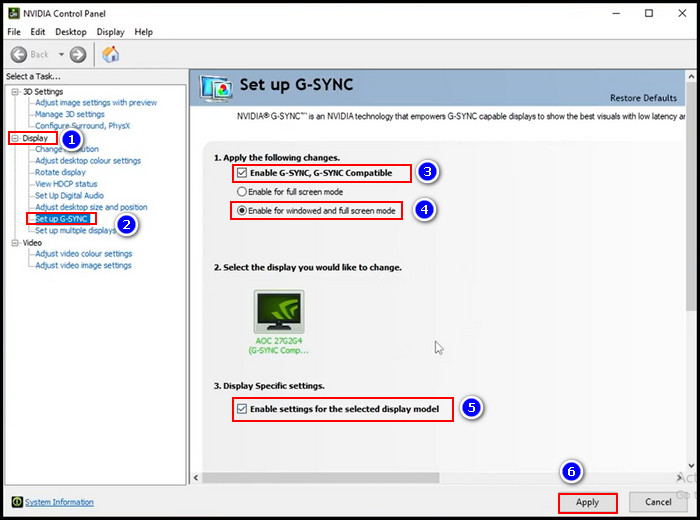
For AMD
- Right-click on anywhere on the desktop screen and select AMD Radeon Settings.
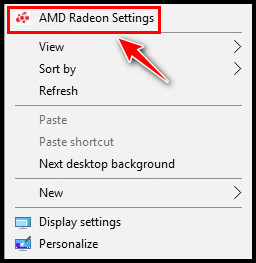
- Press on the Display option.
- Locate AMD FreeSync and click the toggle icon to turn on the option.
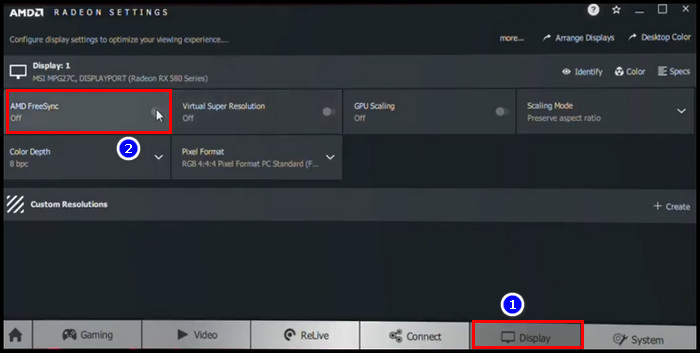
Note: These features can be used on some compatible monitors and GPUs. Don’t be surprised if they are not available on your PC.
FreeSync is only available on AMD. Check our exciting guide to learn whether FreeSync can work with Nvidia.
2. Use Nvidia FastSync or AMD Enhanced Sync
Besides G-Sync or FreeSync, other advanced features exist in Nvidia & AMD. Those are FastSync, which is for Nvidia, and Enhanced sync, which is for AMD.
One significant advantage is that they can solve the screen tearing even when the game’s fps exceed the monitor’s refresh rate. This advantage makes them different from Nvidia’s G-Sync or AMD’s FreeSync.
Moreover, they can be compatible with any GPU and monitor. Plus, it’s pretty straightforward to turn them on. Check the process to enable them below.
Pursue the following way to enable Nvidia FastSync and AMD Enhanced Sync:
For Nvidia
- Right-click on the desktop screen and select the Nvidia Control Panel option.

- Go to the Manage 3D settings from the left pane and click on it.
- Scroll down to the Vertical sync section.
- Expand the menu and select the Fast option.
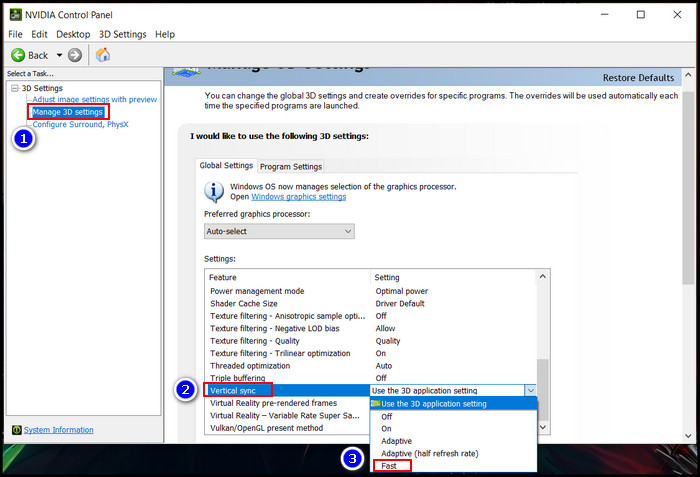
For AMD
- Right-click on anywhere on the desktop screen and select AMD Radeon Settings.

- Go to the Graphics section.
- Find the Radeon Enhanced Sync and enable that option.
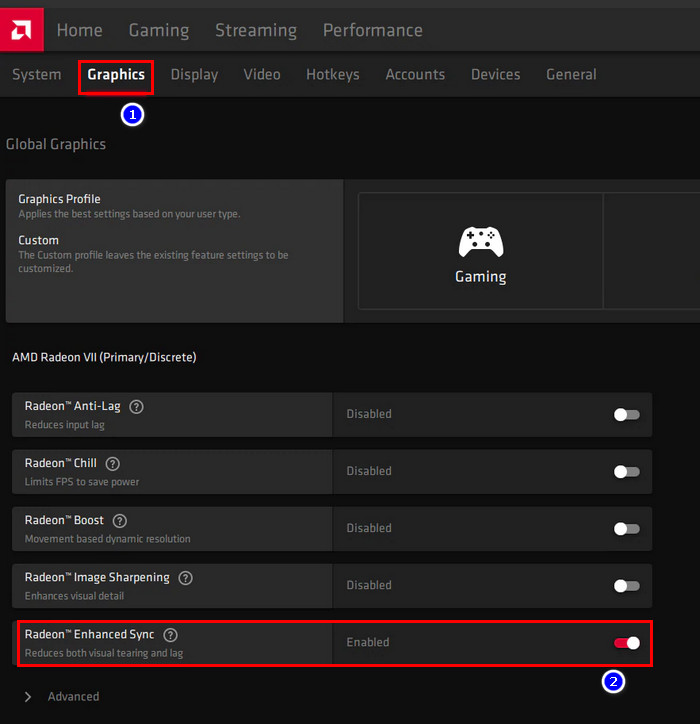
There are a lot of things in VSync and FastSync that you might be interested in. If you do, check out our V-Sync vs. Fast Sync article to learn everything about them.
3. Use Nvidia Profile Inspector
You can use a third-party tool to change the frame rate and fix screen tearing. There are many tools you will find on the internet for that.
But I suggest you use the Nvidia Profile Inspector application. It’s pretty easy to work around with this app.
Before you modify your frame rate, you must know your monitor’s refresh rate.
Don’t you know how much it is? Go to Settings > System > Display > Advanced display settings.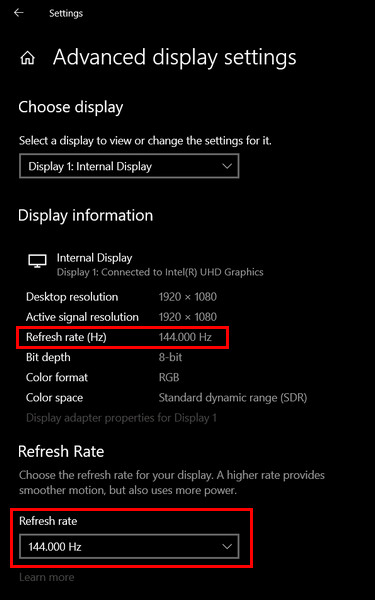
Afterward, you can go for the Nvidia Profile Inspector application and lock your fps to stop screen tearing. Follow the steps below.
Take the following steps to download the Nvidia profile inspector application and limit the frame rate using it:
- Go to the Nvidia profile inspector website and download the application.
- Extract the zip file and click the .exe file to run the application.
- Go to the Sync and Refresh section.
- Expand the Frame Rate Limiter option and set your required frame rate.
- Click Apply Changes from the top-right corner to save the changes.
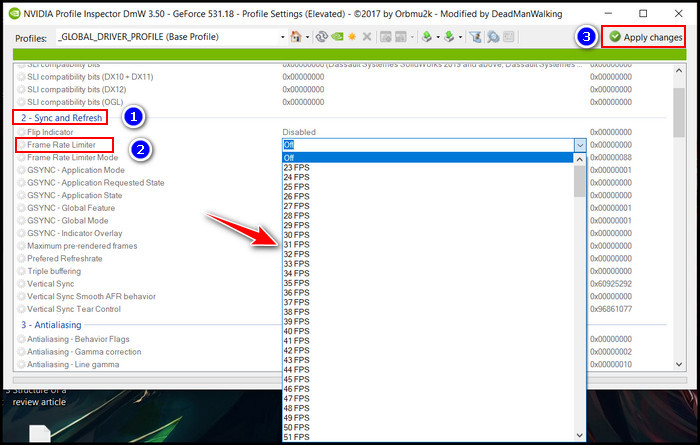
Note: Make sure you choose a frame rate lower than your monitor’s refresh rate.
Go through our epic guide about what does Ti stand for in GPU?
4. Update or Reinstall Graphics Driver
Your graphic driver can cause a tearing issue on your screen. It can happen due to two reasons. One, you are not using the latest driver version of your GPU. And two, you updated your GPU driver, but the problem started after that.
If the reason is the first one, you must update your GPU driver. In case it’s the second one, you must uninstall the latest driver and reinstall the previous compatible driver.
Below, I have explained both processes. Let’s look at how to do this.
Take the following way to update and uninstall-reinstall your GPU driver:
Update the GPU Driver
- Right-click on the Windows icon from the bottom left corner and select Device Manager.

- Expand the Display adapters.
- Right-click on your graphics driver and select the Update driver.
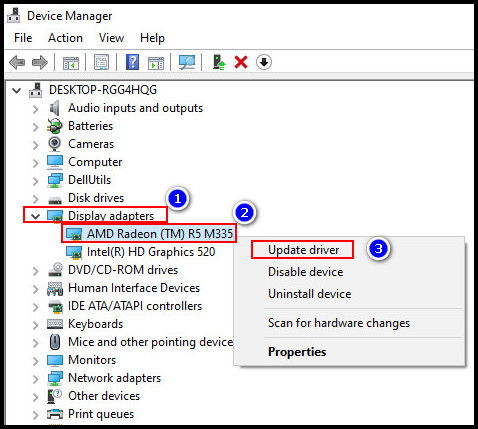
- Pick any one between the two options to start the updating process.
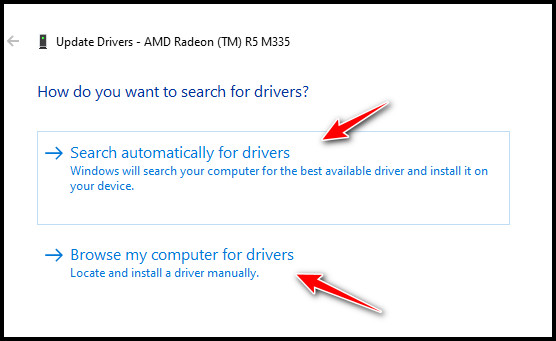
Choose the first Search automatically for drivers option to complete the update automatically.
Or, you can select the second Browse my computer for driver option if you have already manually downloaded the driver from the manufacturer’s website.
Uninstall and install the GPU driver
- Right-click on the Windows icon from the bottom left corner and select Device Manager.

- Expand the Display adapters.
- Right-click on your graphics driver and select Uninstall device.
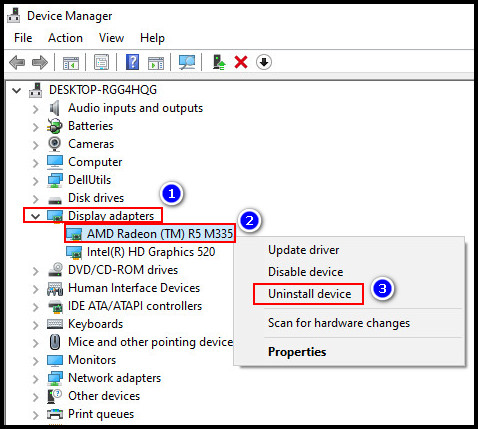
- Follow the rest of the on-screen process in the wizard to finish uninstalling the driver.
- Restart your PC after uninstalling your driver.
- Go to the location on your PC where you kept the recently downloaded GPU driver file and press double-click on it.
- Click on Next and go through the rest of the wizard to complete the installation.
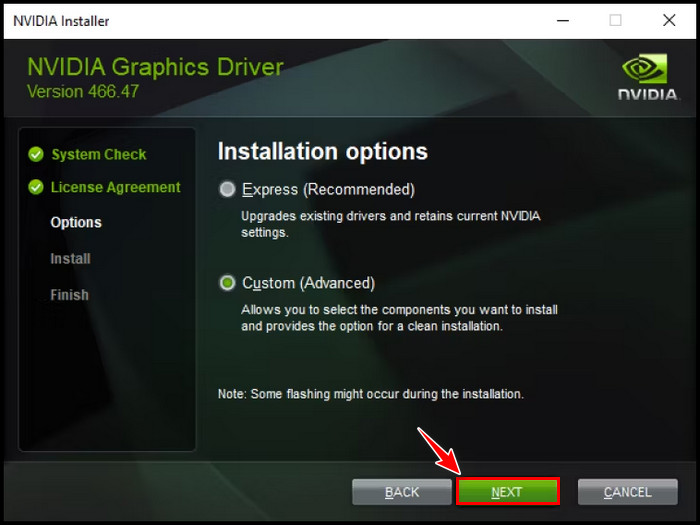
Your Graphics driver may be on the verge of dying. Read our excellent guide to know the signs that your GPU is dying.
5. Adjust Your Display Settings
You can also fix screen tearing by lowering the PC’s screen resolution. When you drop your display resolution by a little, it enhances your graphics performance. Because of that, the chance of screen tearing is reduced.
Here is the process to adjust the display setting from the Windows settings:
- Go to Windows Settings.
- Click on System.
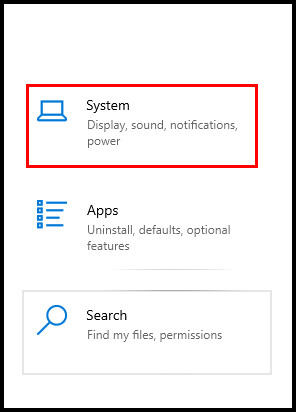
- Select Display.
- Go to the right pane and click on Advanced display settings.
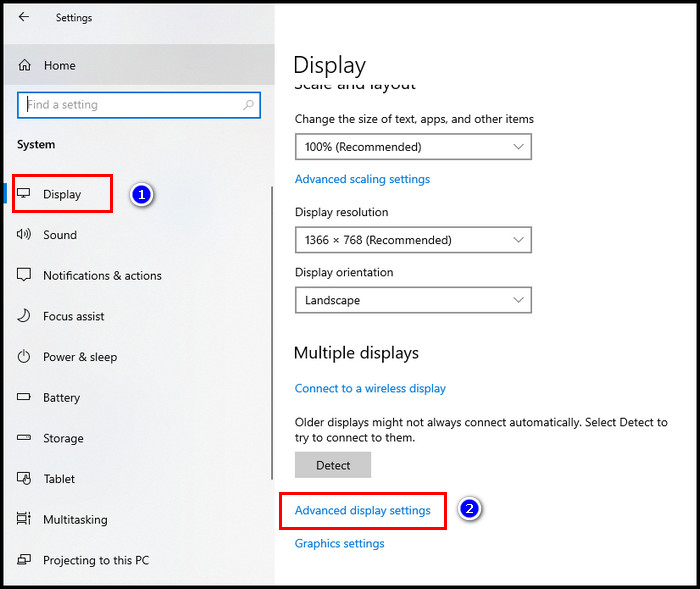
- Press on Display adapter properties for Display 1.
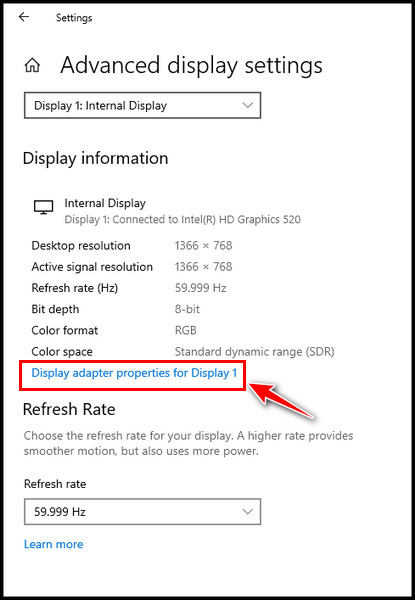
- Click on the Adapter tab and select List All Modes.
- Select the lower display resolution.
- Click OK to save the changes.
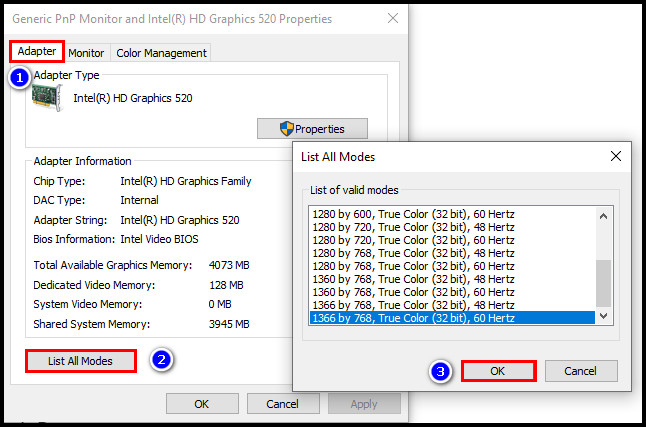
6. Purchase A New Monitor
If the screen tearing occurs because of the monitor, you must change it and replace it with a better one. But you should consider this option if your monitor is too old and has a history of getting damaged.
Otherwise, changing a good monitor is pointless only to avoid screen tearing.
If you plan to replace your monitor, go for the higher refresh rate model monitor. To save some bucks, if you buy the lower refresh rate ones, you will again face a screen tearing issue.
You may find as high as 360 Hz refresh rate monitors in the market. It’s pretty high enough for the most dedicated games.
Why Does Screen Tearing Happen?
Due to the mismatch between the GPUs frame rate and the monitor’s refresh rate, screen tearing happens. Besides, if the VSync somehow gets disabled and the graphics card driver’s rendering is poor, screen tearing can occur while playing video games.
Among the reasons, dissimilarities between the GPU frame rate and the monitor’s refresh rate are the leading cause of tearing on your display screen.
For example, let’s assume your monitor’s refresh rate is around 60Hz. It means the monitor refreshes 60 times per second and displays 60 individual frames per second. But, the irony is the games you are playing render above 60 frames per second.
When you start playing any game, it provides more frames that your monitor cannot display. That’s why screen tearing occurs.
Moreover, poor rendering also causes screen tearing. Are you wondering how?
Occasionally, the graphics cards can’t smoothly send a frame to display. Because of that, a mismatch creates between the frame and refresh rates. That’s the reason you can see that the screen is tearing.
It can happen even if the refresh and frame rates are the same.
Are you always using high FPS but not getting a smooth display? Then check out our separate guide to why your display is not smooth despite high FPS.
Is Screen Tearing bad?
In short, yes. Screen tearing is terrible. Mostly, it’s problematic and annoying when you play any fast-paced video game. During gameplay, you may experience stuttering, lag, and other issues because of that. Moreover, it’s unpleasant for the eye.
It will be an unfortunate moment for you if screen tearing suddenly appears on your monitor. Your overall visual experience will get spoiled because of that.
With a screen-tearing display, it’s hard to aim or react in video games. Moreover, you won’t be able to enjoy any TV show or NBA games with a broken screen.
I was so angry at my monitor when I couldn’t enjoy the moment while LeBron James broke the all-time NBA scoring record. If the same thing happened to you, I could feel your pain.
You can realize now how bad screen tearing is.
FAQs
What is an alternative to VSync?
The alternatives to VSync are AMD FreeSync, Nvidia G-Sync, etc. These help the PC avoid having any decreased frame rate and input lag issues.
Does higher FPS reduce screen tearing?
No, a higher FPS doesn’t reduce screen tearing. To prevent screen tearing, your graphics card settings should stay at a lower FPS.
How do I get rid of screen tearing?
To get rid of screen tearing, you must adjust the refresh rate and your game & screen resolution. Also, ensure your GPU driver is updated to the latest version and that they are configured correctly.
Final Thought
To prevent screen tearing, matching the GPUs frame rate with the monitor’s refresh rate is essential. That’s why always keep the V-Sync or G-Sync enabled.
Additionally, you should use a monitor with a high refresh rate and fast response time. It can reduce the occurrence of screen tearing by a lot.
I hope you resolve your screen tearing problem by following the methods. Let me know in the comment section which method helped you fix the issue. You can also comment if you have any queries.
Peace!

